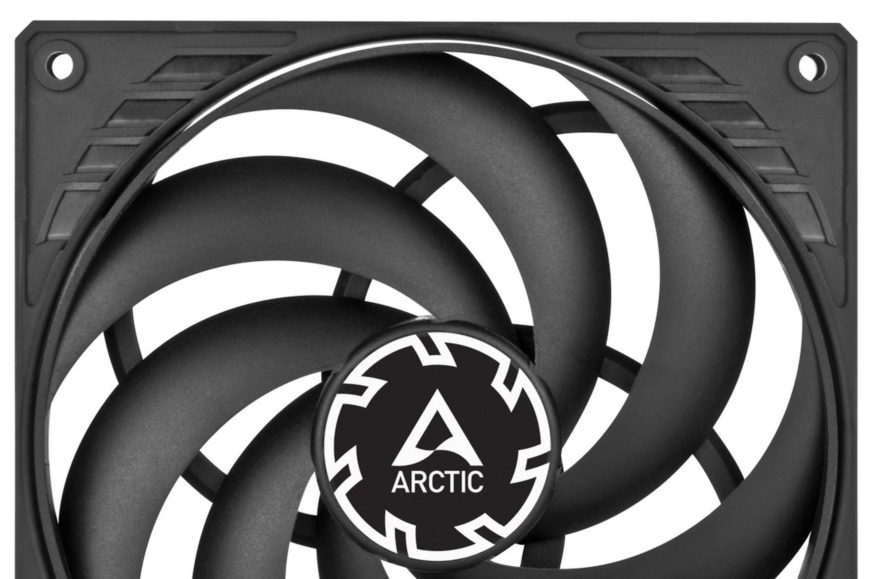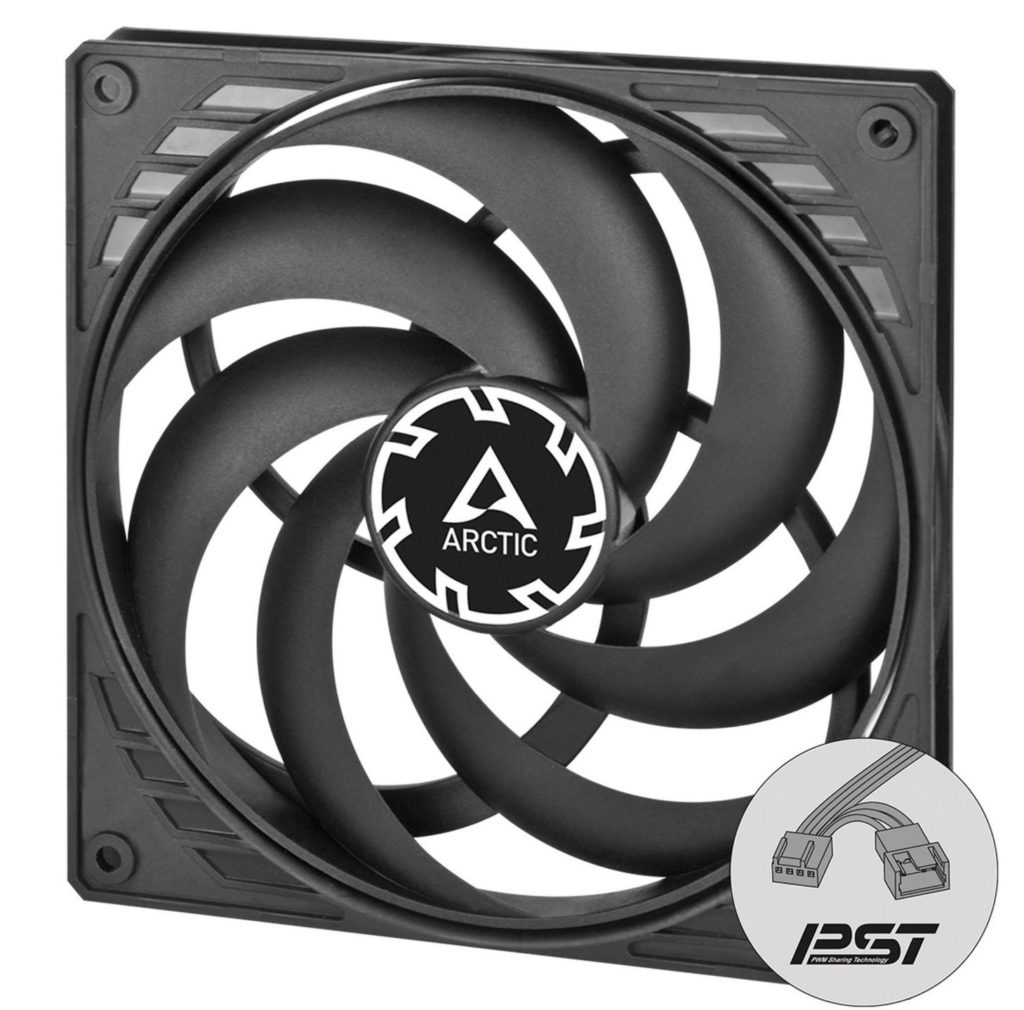Second revision of the Arctic P14 Slim PWM PST
If you bought the P14 Slim PWM PST some time ago (and by that I mean earlier this year), its design differs from its current form. And quite significantly so. It is in fact that it has quietly advanced to the second revision. But it did so so quietly that many, including us, missed it. What are the changes and how do you identify the new version so that you don’t order the older, inferior one?
The P14 Slim PWM PST fan is one of the few 140mm models with reduced thickness (to 16mm). As such, this format struggles with more delicate blades, and especially when they are significantly curved, as Arctic does it, they flex significantly. Not only are they long, but the profile of the blades is also very low, meaning they are slim, and that doesn’t add to the stiffness either.
The excessive vibration that occurs at the tips of the blades has been solved by Arctic in the same way as it has done on other fans recently – with a rotor frame. At first, it was not on the P14 Slim PWM PST fans, but now only variants with it are produced and shipped. Arctic got to those in March this year, and their distribution is already well underway.
Most stores should only stock these new variants now, but it may be possible to buy a fan without a frame as part of a clearance sale. To avoid this, you need to ask the retailer if this is the second revision. This marking is on the back of the packaging, where it must say “rev. 2” above the EAN code. If it is not there like that, it is the original design. It is also possible to check by the box graphic, this has also changed. The long code designation of the fan (ACFAN00268A) has remained the same, do not navigate by it.
The main benefit of implementing a rotor frame is in the suppression of tonal peaks that arise with certain vibrations. Stabilizing the blade tips does not mean that the fan is completely free of vibrations (they will be there), but it eliminates oscillations that degrade acoustic performance (by accentuating critical/resonant frequencies).
The direct framing of the blades also has a certain effect on the aerodynamic properties, because the airflow is not torn away from the tips (blades). However, the addition of such a frame is often associated with a small shortening of the blades, reducing their surface area, which in turn reduces the airflow at the same speed.Thus, in the final analysis, there may be no performance improvement, which is substantially evidenced by the parameters across the revisions – the airflow is quoted at 88.35 m³/h and the static pressure at 1.55 mm H2O. If these specs are correct, Arctic has incorporated the frame so that the specs of the new revision will scale with the old one. The speed range of both fans is the same 150–1800 rpm similar to the motor or (fluid) bearings used.
The price in the Arctic e-shop is unchanged – 12.99 EUR, but elsewhere you can buy the P14 Slim PWM PST rev. 2 fan for 2–3 euros cheaper.
English translation and edit by Jozef Dudáš














I didn’t think of P14 Slim as much before, and in the end, I couldn’t find an older version of it on the market in my region. Now I only have 2 P14 Slim Rev.2 but no P14 Slim Rev.1 🙁
I want to compare them but sadly it seems that Rev.1 is now end-of-life.
Have you tried writing directly to Arctic? I suppose they might still have some archive pieces of rev. 1 and at the same time they might be interested in it – a comparison across revisions to point out possible improvements. And yes, rev. 1 is already EOL and shouldn’t be out of stock in most stores. This is the official Arctic statement.
I was also thinking about doing this comparison, but we are behind on so many things that I changed my mind. Anyway, the comparison of framed Arctic fans with 25 mm thickness doesn’t show so well the influence of the rotor frame, because many variables… The P12 A-RGB has, besides a different rotor material with different stiffness and hardness, a larger inner rotor diameter and therefore shorter blades. And the same applies to the P12 Max.
OK, I’ll contact Arctic about this fan right away!
Have you managed to make any progress on the P14 Slim revisions (1 vs. 2) tests? I’ll occasionally think that it would probably be a good thing to do, but your results would be enough for me. But if nobody would pursue it and it would be forgotten, I think it would be a great pity.
I failed to get P14 Slim Rev.1 from Arctic because Rev.1 is completely sold out. But fortunately, my one reader lent Rev.1 for me about 6 days ago, and I received it by courier yesterday. I’m now preparing for various tests to compare two revisions.
This work may take some time. If I collected some data about them enough, I’ll share with you and community. Thank you for your encouragement!
I got some airflow results (for no obstacle and filter intake, but not open them to the public yet) and checked the change of design parameters.
1. Design parameters
i) Rev.2 has tighter gap between an edge of a blade and an inner frame than that of Rev.1.
The gap between a blade and an inner frame: ~1mm → ~3mm
ii) Rev.2’s rotor is placed higher than Rev.1.
The rotor depth from a front of frame: 2~3mm → 0~1mm
The thickness of rear struts: ~2mm → ~4mm
iii) The diameter of a motor hub stays same as ~42mm.
2. Airflow results
Regarding the standardized noise-airflow results, Rev.2 always reaches higher airflow for both no obstacle and filter intake. Rev.2 showed about 20% better efficiency. (The specific values vary in detail, of course.)
And, Rev.2 makes slightly higher maximum airflow than that of Rev.1, but lower maximum noise level.
3. Resonance
On the other hand, Rev.1 has some RPM points that makes tonal peaks by a resonance, but Rev.2 has much less resonant points.
4. Motor
And, the motor seems to be not changed. Not only does the rumbling sound by raising RPM and the continuous motor noise exist in Rev.1, but also in Rev.2.
More planned tests remained, so I’ll show you the specific data when I complete some measurements.
* Edit: The gap between a blade and an inner frame: ~3mm → ~1mm
Wow, that’s a lot more changes that I expected.
The struts increased in thickness, and the hub also raised by the same amount. I would guess that the rotor has the same overall thickness and shape (except for the ring), but it was simply raised by 2 mm. Perhaps it’s done to increase overall rigidity. The blades being that close to the intake side might cause more collisions though, not just for nylon filters (I have seen complaints on Rev 1 hitting radiators on the intake side, for example). I wonder if this aspect has been improved despite the tighter clearance.
The performance improvements are very welcome, bur it’s strange that no changes to fan specifications were made. A lot of it probably comes from the tighter gap between the rotor and the inner frame, such that the the blade length remains almost the same. Anyway, not enough improvements for me to upgrade yet🤪
I should play around with my P14 slim rev 1 more today, I run it only at <1000 RPM so I couldn't really hear any resonance. I do feel a low frequency noise when the fan is spinning though. Perhaps that's the motor noise you have mentioned.
Lastly, Arctic (and Cooler Master to an extent) have shown that the ringed blade design can be very effective if there is some constraint on blade strength (limited materials due to cost/RGB, and limited thickness to work with in the case of P14 slim). Perhaps we will see more budget-friendly fans adopting such design in the future.
Yeah, I also didn’t expect to find out such many differences.
I think the possibility of collision with an object in front of a fan was improved not much. The manufacturer designed the clearance too tightly. Maybe collision will still occur for some scenarios even though Rev.2 has more rigid rotor..
When it comes to the performance specifications, I assume that the changes of a rotor didn’t affect the measurement of Max airflow/static pressure/noise level or the company just didn’t update the parameters yet.
Anyway, the noise-airflow performance certainly seems to have enhanced by suppressing the minute vibration of rotor and making the gap narrower. I’m testing both revisions for 6 obstacles and the results are showing me the similar tendency.
I think P12 Slim will be also able to become better by simply adding an outer ring!
Thank you for sharing very useful knowledge. I look forward to the complete analysis and results on Quasarzone! 🙂
I bought the P14 slim the day it was released so I happen to have a Rev. 1. I couldn’t detect any resonance noises similar to the P12, but there are some weird scratching-like noise that happen seemingly randomly (e.g. when changing RPMs, starting or spinning down, or at certain RPM ranges) when the fan is not mounted, or if not mounted with enough force. Strangely, the noise goes away when I mount the fan with enough force. Perhaps the frame deformed enough with high pressure to avoid the issue.
There have been numerous reports from users where the blades easily break, and they scratch against case panels/radiators when used in pull configurations. Considering how fast Arctic made the change and how it was silently implemented, I would guess that in this specific case the ring was added mainly to improve reliability, in response to large number of returned fans due to them breaking in some way. A word from Arctic themselves would be nice to understand exactly why this change was made.
There is also a difference in sound colour when comparing the P12 Slim PWM PST with the P12 PWM PST. The slim variant does not have distinct tonal peaks at lower frequencies. At higher speeds some do appear, but they are still much smaller than in the P12 PWM PST, so the rumble is not so characteristic of the P12 Slim PWM PST. The bigger peaks are at higher “humming” frequencies around 380 Hz, which could also be influenced by the circular framing. Although probably only minimally…
The reason why the P12 Slim PWM PST does not rumble is that even at higher vibrations the blade design is not sensitive to resonant frequencies that would in practice encourage a rumbling sound. This does not mean that the fan does not vibrate and certainly the P14 Slim PWM PST will vibrate to some extent regardless of the revision. This is because the vibration from the rotor is transmitted to the frame, which can result in what you are describing. At different pressure to the case, the vibrations create a different sound and with a worse contact, there can be, in the vernacular, rattling?
Yes, the framing of the rotor can also be a prevention against damage to the blades, although with the thin profile it will still be prone to deformation even under the influence of little force.
I do not think the noise I described is due to frame vibrations, as they still occur and sound the same when I held the fan on my hand away from the case. The fan does not seem to vibrate much either when I put it free on my table. Not scientific at all, I know, but that’s my observations.
It sounds similar to when the blades come in contact with some loose cables, but I was unable to find any contact of the blades with the frame or the cables… Very strange indeed. I did add some anti-vibration pads along with strong mounting force but I’m not sure if the pads are actually contribute by dampening vibrations. With the pads, the sound still occur unless I tighten the fan screws further.
Yeah. It could also be some resonance frequency from the airflow that arises in combination with the stator blades, which are very close, or closer than in the case of fans with a standard thickness of 25 mm. I don’t see this sound in the P12 Slim PWM PST spectrograms, but that doesn’t mean that it doesn’t appear in the larger model. We may eventually look at these fans and also a comparison of the revisions with each other. I was saying that we’ll put them on the back burner (which we may eventually do), because it’s a more marginal format that fewer users are interested in, so it won’t be that useful, but… the thirst for knowledge is quite strong. Well, we’ll see at what stage we get there. 🙂